Scientific Facts
| Common Name: | Silver rabbit |
| Scientific Name: | Oryctolagus cuniculus |
| Life Span: | 7 to 10 years |
| Size (Adult): | Medium |
| Weight (Adult) | 4 to 7 pounds |
| Habitat: | Human homes, farms, fields, gardens |
| Body Shape: | Compact |
| Country of Origin: | Portugal |
Physical Description
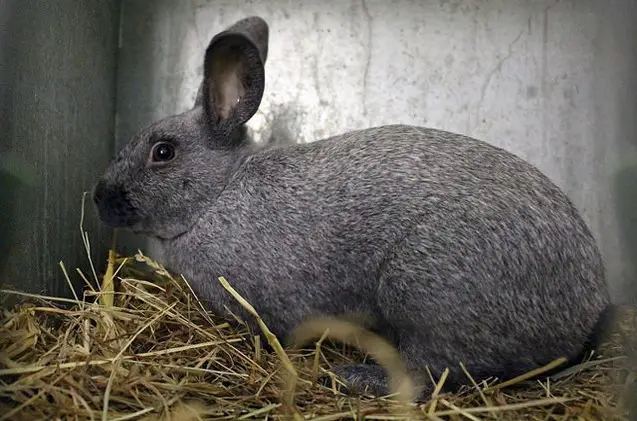
The silver rabbit is a medium-sized rabbit with a compact, muscular body. An adult rabbit has a stocky body that weighs from 4 to 7 pounds. It has short ears that are always erect, forming a V formation on top of its head. The coat of a silver rabbit is dense with a flyback fur. Run your hand over the fur in the opposite direction, and it will quickly snap back to its original position.
The silver rabbit is usually brown, fawn, or a combination of dark colors. There are white guard hairs visible to the naked eye, and this gives the silver rabbit the characteristic silvery appearance. And despite the uniqueness of the silver’s fur, it does not need any grooming technique.
The only accepted colors of the silver rabbit are black, brown, and fawn. There are no marks or speckles on its fur to distinguish it from other rabbit breeds.
History of the Breed
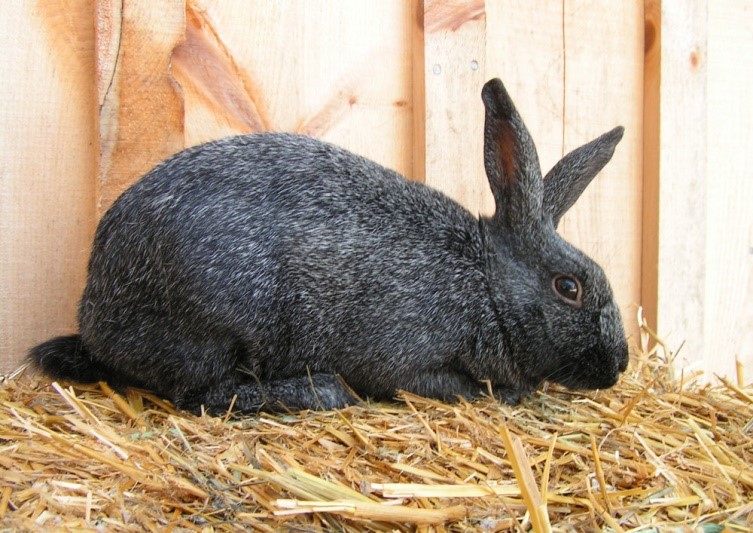
The silver rabbit is the oldest-recorded domesticated rabbit breed. Experts say that the breed dates back to the 1500s. One particular theory of how the silver rabbit was developed was about Sir Walter Raleigh, who was said to have introduced the breed to England from Portugal in 1952. Raleigh kept the rabbits in warrens located in a large area of land, which was surrounded by stone fences.
But it was only in 1910 when the silver rabbit was introduced in the US and accepted by the American Rabbit Breeders Association, which was then called the National Pet Stock Association. It was one of the first rabbit breeds recognized by ARBA, and now, it is accepted in three colors black, fawn, and brown.
Fast Facts
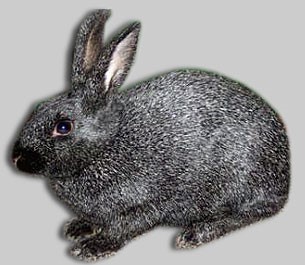
The silver rabbit is known as a rare breed. The original silver rabbit is only found in the United Kingdom and the United States; therefore, you may need to travel far and spend a lot of money getting a rare one. But if you’re only looking for a pet rabbit, mixed-breed ones are easier to find.
Reproduction

Breeding happens all year round for silver rabbits, and in captivity, the males and females are introduced in one cage and the two force mate. The female will usually freeze as the male tries to smell her. She may also run away from the male. She will lie down and allow the male to smell and mount her when she’s okay with mating, and usually, this is done very quickly. The male will leave the female alone once the mating success.
Females are usually separated from males after breeding success. Breeders place her in a cage and feed her extra food, and the cage is made comfortable with more hay. The gestation period for rabbits is up to 38 days. A sign that the female is about to give birth when she loses interest in food and water, and she will look for a suitable nest inside the enclosure.
A nesting box is offered, and this is lined with hay. The pregnant female will use hay and her fur to line the nest to keep her babies warm. After a short while, she will give birth to 3 to 5 babies who are small, naked, deaf, and blind. The babies will nurse only for a short while with the mother out of the nest all day and comes back for a short while in the evenings to nurse. At three weeks, the babies are weaned, and then these leave the nest. Like other rabbits, silver rabbits are ready to mate at five months.
Fun Facts
The silver rabbit is a calm and gentle breed, which is why it’s popular among families, children, singles, and seniors. This rabbit is not too large and not too small, and thus, it’s just the perfect size for young children to hold and cuddle. If you are looking for a cozy, warm bunny to cuddle, then the silver rabbit may be the pet for you.
Personality and Behavior
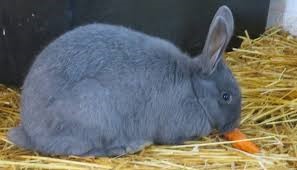
The silver rabbit is calm, gentle, and easy to train. It is ideal for singles, seniors, and couples who are looking for a kind-natured pet. It can be properly trained, so it will remain calm and friendly when handled by small children.
Silver rabbits are active and love to be out of their cages to stretch, play, and socialize. This rabbit grooms their bodies meticulously and may even take hours to do so. It will also groom socially, and experts say that this is one way to improve their relationship with their group.
You can start training your pet silver rabbit as soon as these are home. Start by offering food or treats. Have a lot of patience and use repetition or rewards to hone its friendly, calm, and docile behavior.
Comparable Breeds
The silver rabbit is comparable to the satin rabbit and the Havana rabbit. The satin rabbit is a medium-sized rabbit just like the silver rabbit. It weighs 8.5 to 11 pounds and has a commercial shape, as well. It has a calm, gentle nature, is affectionate and sweet, and thus is perfect for singles, families, and seniors.
Meanwhile, Havana rabbits are medium-sized rabbits with weights from 4.5 to 6.5 pounds with a compact body. This is a calm, playful, and affectionate breed that’s perfect for singles, seniors, and first-time rabbit owners.
Care of Silver rabbits
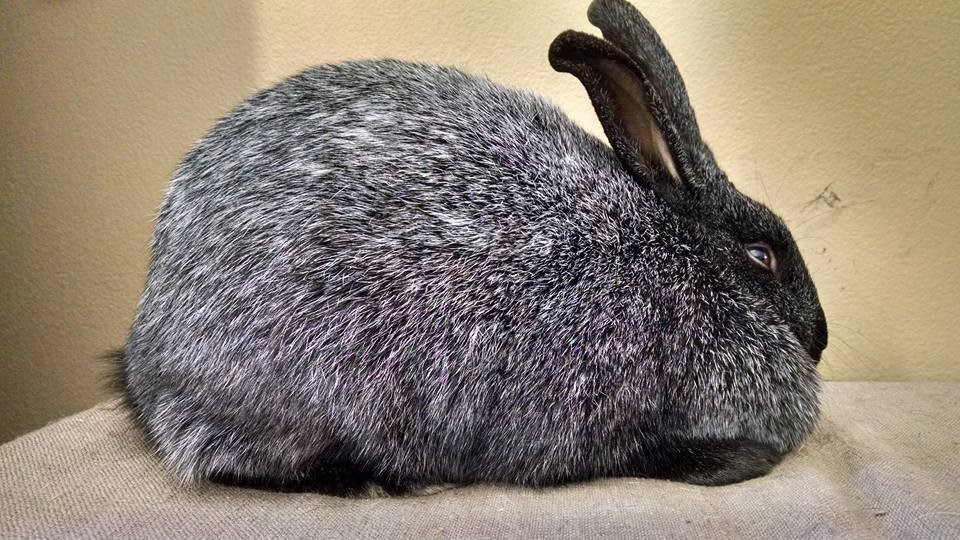
The care of a Silver rabbit is like that of other domesticated rabbit breeds. There are four basic pillars of care of a silver rabbit. must make sure you’re your pet has the correct diet, the right housing or enclosure, companionship, and proper medical treatment.
An important part of a rabbit’s diet is hay. Hay is considered the bulk of a rabbit’s diet, but you may also feed these rabbit pellets developed for rabbits. Commercially-prepared food has added vitamins and minerals for your rabbit’s good health. You may add vegetables and fruits, which creates a healthy, well-rounded diet for your pet.
Give your pets unlimited fresh water and hay. Hay is vital to a rabbit’s daily diet because it’s rough and helps keep their digestive tracts healthy and regular. Place the water in a heavy shallow dish so your rabbit can easily drink from it.
Be sure that your pet is eating safe, natural food. Feed it organic food that’s free from chemicals, toxins, and herbicides. Younger rabbits need alfalfa hay because it’s rich in calcium, which is needed for growing bones. Meanwhile, adult Silver rabbits will eat legume hay.
Captive-bred Silver rabbits are lovable, calm, and docile pets, but you must train them well. Interact regularly with your pet rabbit by playing with it. Rabbits are social animals and thus will need fellow rabbits aside from interacting with their owners. Rabbits that grow up with constant companions and daily interactions with their owners are healthier, happier, and have a well-rounded temperament.
Silver rabbits are meticulous when it comes to grooming. These rabbits will groom themselves for many hours before they’re done. Rabbits may also groom each other, and experts to say this is a way to bond with their cage mates. The mother rabbits can also be seen grooming her kits in the nest and while feeding her babies, but this won’t last long. She won’t stay long in the nest and will return only at night to nurse her babies.
Silver rabbits are most active in the daytime and sleep in the evenings. Therefore, feeding your pet Silver rabbit should be done in the morning when the rabbits are up and are very active. Captive rabbits usually sleep 8 hours a day, and may also sleep huddled together to keep warm. Therefore, when designing a cage or enclosure for your pet rabbits, construct a large area where they can eat, play, rest, and sleep.
Supplies and Cages
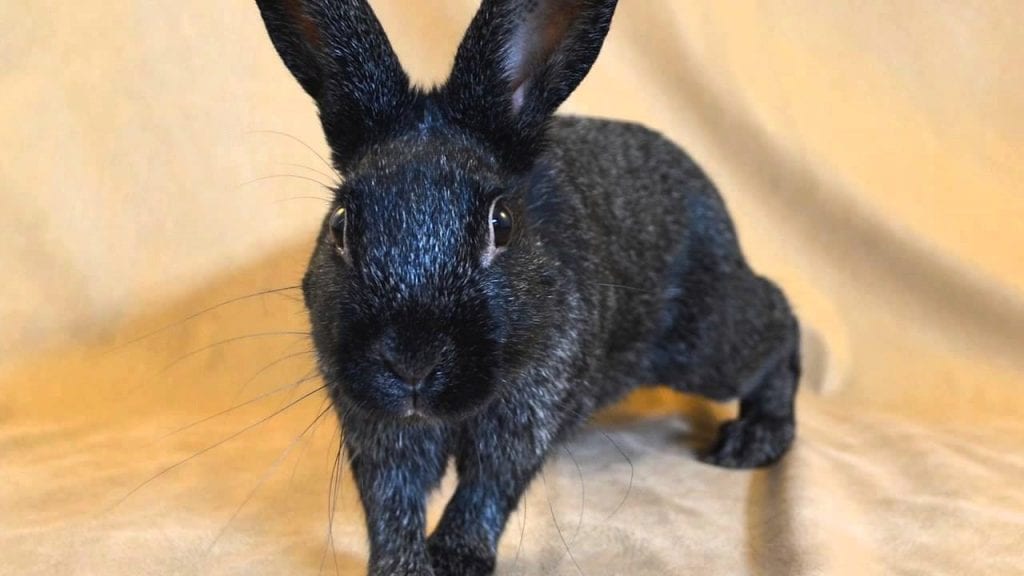
The ideal cage for captive Silver rabbits should be constructed with strong wire and have a strong metal or wooden frame. The bottom must be removable because this is where the rabbit’s droppings will easily fall. This pan makes it easier to clean the cage too. The floor must have soft bedding to make it more comfortable for your pet rabbits.
A rabbit hay feeder may be installed on the side of the enclosure. Fill this with hay so your rabbit can eat when it feels hungry or when it wants to chew hay when it’s boring. For the cage bedding, you must only use hay, wood pellets, or horse bedding.
To maintain the rabbit cage, remove your pets first and place these inside a safe and clean enclosure. You must use only a safe cleaner or natural cleaning product like white vinegar and water, baking soda and water or lemon juice. Never use household cleaners because these may have toxic ingredients that can be dangerous to your pet’s health.
If you are planning on breeding rabbits, you must also consider a separate or extra cage. These rabbits are born naked, deaf, and blind, therefore. They are very vulnerable to the cold and also to predators. Babies need a warm enclosure to keep the right temperatures. Place the kits in a smaller cage with cage lamp or lighting to keep these dry, warm and safe.
Also, Silver rabbits will love chewing on things, and if these are kept indoors, these will chew on anything made of wood such as wooden walls, fixtures, and furniture made of wood. This rabbit can also chew on electrical wiring. So to avoid accidents, provide hay or chew toys inside the cage. You must also rabbit-proof your home before releasing your pet from its cage.
Health Concerns
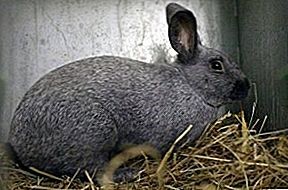
A Silver rabbit is a healthy breed and is not usually affected by the disease. The most common conditions that the Silver rabbit may be affected with are common pests such as mites, ticks, and fleas. These are naturally found in their environment and may be hard to avoid.
Silver rabbits are not immune to common diseases of rabbits. You must monitor your rabbit’s health and temperament because any change may be due to an illness. So, as early as your rabbit can open its eyes and get out of its nest, you must take it to the vet for vaccinations and tests.
Your vet will give it some tests to assess the overall health and development of your pet. Also, take note that there are rabbits with sensitive digestive systems and thus may be prone to different health conditions that affect the digestive system like enteritis, bloat, and stasis. These may affect rabbits that are less than two months of age.
You must check for ear or fur parasites. The most common are mites, fleas, and ticks. Usually, rabbits that are affected by these pests lack hygiene and are kept in dirty cages and enclosures.
Monitor your rabbit for any signs of illness such as poor appetite, diarrhea, constipation, nasal and eye discharges, and vomiting. Consider unsteady gait, restlessness, the grating of the teeth, and sleeping for many periods signs of serious health conditions, and therefore, you must visit your vet right away.
Another very important part of caring for rabbits and other pets is deworming. Your Silver rabbit should be treated for worms at least once a year and should be conducted during springtime and fall. Keep in mind that this is an important concern especially with rabbits that come from the wild or who come from wild parents
All rabbit breeds should be dewormed ASAP. Use a small, pea-sized amount of deworming paste. Put this in the rabbit’s mouth, and the rabbit will continuously lick and swallow the medication until this is gone. You should follow the dose prescribed by your vet. Repeat this after a few months.
Dental Care
Take note that a rabbit’s teeth will continue to grow, and sometimes, their teeth can grow very long, and this can pierce the mouth and gums, causing pain and can affect the appetite of your rabbit. You must make sure that the rabbit’s teeth don’t overgrow, and one of the ways to do this is by offering hay. Hay can files down the rabbit’s teeth naturally as the rabbit chews. You can also use small pieces of wood, wooden baskets, or other cage accessories that can file the rabbit’s teeth. Check your rabbit’s dental health to save expensive dental bills in the long run.
Spaying or Neutering
A responsible pet owner will control the rabbit population and breeding by spaying or neutering their pet or pets. Controlling breeding is also healthy for rabbits, and this can also preserve their health.
Spaying and neutering are usually done at a young age. However, some vets may wait until the rabbits are six months old so that the rabbits are ready. Silver rabbit bucks are also neutered at a young age because experts say that this reduces aggression. Bucks may be neutered as young as three months. For any question about spaying and neutering, talk to your vet.
Grooming

Silver rabbits have short furs, depending on the color of the coat. This rabbit will need regular grooming by brushing. This will keep it clean, shiny, and free from pests. Use a small brush at least once or twice a week to keep the coat in perfect shape.
Grooming must also be done more frequently during the molting period. Molting is when the rabbit sheds its fur to make way for a new one. Brushing during molting can prevent wool blocks and will keep the rabbit from ingesting their fur. The fur is indigestible and can accumulate in the digestive tract causing blockage and other severe complications. So help your pet groom and avoid wool block by brushing it regularly.
A rabbit will become dirty if you leave it outdoors to play, but don’t bath it because this can cause stress. You may use a damp towel to spot clean. Just wipe the rabbit down with the towel and use a dry one to finish its “bath.”
You must also trim your rabbit’s nails monthly and check its mouth for overgrown teeth. Clean its large ears to avoid any pests and wool blocks from the ears.
Availability – Where to Get One
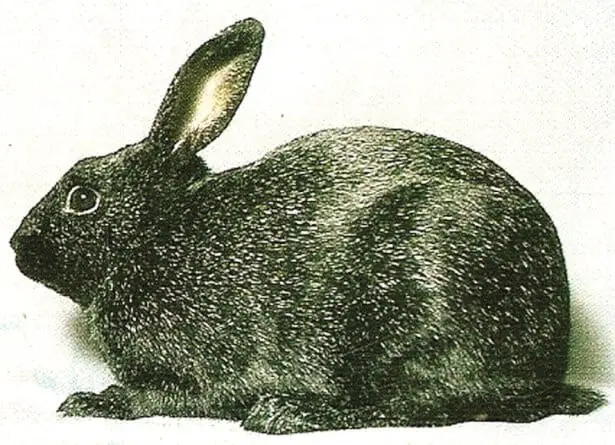
The cost of purchasing a Silver rabbit may depend on whether you are getting it from a breeder or a retailer. The price will also depend on whether you are getting a rabbit for a pet or show. The price may vary depending on the gender, size, quality of the coat, and overall appearance.
If you are looking for a good breeder, be sure that you are getting a healthy one and a rabbit with no genetic disorder. Purchase rabbits only from reliable breeders who raise healthy rabbits. This breed is present in trade fairs and farm events. There are also shows and contests sponsored by the ARBA that feature the Silver rabbit breed.
How to Care for a Silver rabbit
This is a summary of how to care for the Silver rabbit breed. Caring for a Silver rabbit is like caring for other breeds. Remember that you must provide the correct diet, housing, companionship, and medical care.
The main food of rabbits is hay, and this is important in their diet so they can chew this to grind their growing teeth to keep their digestive system healthy and for regular bowel movements. Feed your rabbit pellets, vegetables, and fruits for a well-rounded diet. Provide them food that is found in natural rabbit habitats such as grasses, twigs, birch, roots, and weeds.
Have clean and freshwater and hay available inside the rabbit’s cage. Hay is rough and will keep their digestive tracts healthy and regular. Also, place water in a large, heavy shallow dish so that your rabbit can drink from it and won’t knock it over as it moves inside their enclosure.
Also, captive-bred rabbits can only become friendly and docile pets when you take time to train and earn their trust. It would help if you train and interact with your pet daily.
Captive rabbits are also social animals and will need a rabbit companion or companions. If you don’t have the resources, space, and patience to care for two or more rabbits, then settle for a dog or cat. A pet rabbit can grow healthy, with good temperament, and with a calm and friendly behavior when it socializes with some cage mates and with you, its owner.
Don’t forget to take your pet to the vet. It needs vaccinations, tests and should be healthy before it can be allowed to socialize with other rabbits and handled by children. Get to know the different signs of illness in rabbits, and for any symptom, take your pet to the vet at once.
FAQs
Are Silver rabbits endangered species?
No, Silver rabbits are not endangered. There are many Silver rabbits available from local and international breeders and in pet shops and human homes kept as pets.
Where do Silver rabbits live?
A Silver rabbit is not found in the wild because these are domesticated animals. These lived in human areas and commercial areas, including breeding kennels, pet shops, and human homes and kept as pets. For Silver rabbit pets, these may be placed in large cages indoors or outdoors.
Can you keep a Silver rabbit as a pet?
Yes, you can keep the Silver rabbit as a pet because of its docile and sweet temperament. It is a good pet for families but not for families with small children because of the size of this breed.
Can Silver rabbits swim?
Yes, Silver rabbits can swim like other rabbit breeds, but it may not be as good as other animals. But most rabbits do not want to get wet and will not like a bath because this can stress them a lot.
How do you tame a rabbit?
A wild rabbit cannot be tamed, and this is not recommended. You might end up getting hurt or worse, bitten. You can train a captive-bred rabbit instead because these rabbits have a docile behavior and are calmer compared to wild rabbits. Captive rabbits may still need constant handling and interaction with their handlers to maintain a tame, happy, and healthy disposition.
Do you place a Silver rabbit’s cage indoors or outdoors?
The location of a rabbit’s cage may depend on your preference, the space in your home, and the climate. You may place the cage indoors to protect it from the elements, but the area could be too small and may not be enough for a large or adult Silver rabbit. When you place your cage outdoors, the rabbits may have to deal with the elements, but they will have a large area for playing, socializing, and lazing around.
How large should a Silver rabbit’s cage be?
A single Silver rabbit must be placed in a large enclosure because of its size. For two rabbits, double this area. You must never overlook the cage size and always make sure that your rabbits have enough space where they can play, eat, and sleep.
Do Silver rabbits eat fruits and vegetables?
Yes, Silver rabbits can eat fruits and vegetables, and aside from these, you may also feed Silver rabbits commercially-prepared pellets or rabbit pellets that contain nutrients that your pet needs to stay healthy.
Should you get a wild rabbit from the forest?
Don’t take a wild animal like a rabbit from the forest. You will not be able to tame it and make it your pet because it will have a wild that you cannot tame. So, if you see an injured wild rabbit, call animal services for help right away.
Will Silver rabbits eat their poop?
Like all rabbit breeds, Silver rabbits will eat their poop because they can tell that this still has nutrients in them. But after eating their poop once, they won’t do it the next time. No one knows why rabbits do this, and you can prevent this by removing their droppings as soon as you see them.
Are Silver rabbits carnivorous?
No, these rabbits are not carnivorous and are herbivores, which means that these won’t eat any kind of meat or animal, insect, or bird. It will only consume plants or plant parts, which are roots, bark, flowers, twigs, leaves, stems, seeds, and many more.
What do Silver rabbits eat?
Silver rabbits are herbivorous, and therefore, it will eat plants. These will consume all plant parts like roots, bark, seeds, weeds, flowers, and leaves. In captivity, it can eat commercially-prepared rabbit food or rabbit pellets, vegetables, and fruits. These may also eat nuts, seeds, and hay.
Are Silver rabbits territorial?
Some breeders say that the Silver rabbit may become territorial when kept in a small cage or enclosure. Males can develop aggressive behavior and can be very dangerous to other males, especially in the breeding season. These can bite, scratch, and kick their rivals to gain hierarchy in a small area or territory.
Do you need a heater inside a Silver rabbit’s cage?
You can use a cage lamp for heat. But in extremely cold climates, you may use a small heater and place this near the rabbit cage to create a comfortable place for your pet. This set up is also nice for incubating newborn rabbits.
Will a mother Silver rabbit eat her young?
Some species will eat their young. Breeders say that if you spot the mother Silver rabbit eating her young, remove it from the nest and don’t let it breed again. Separate the mother in a small cage.
Can you keep two or more Silver rabbits in a cage?
Yes, you can keep two or more rabbits in one cage as long as this is large enough to keep your pets. Remember that the cage should be large, comfortable, and safe, so your rabbit or rabbits will also be comfortable.
Can you leave Silver rabbits indoors to play?
You may allow a rabbit to remain indoors but only under your supervision. Use a portable perimeter fence to cordon areas that the rabbit is not allowed to go. You must rabbit-proof your home before you let your rabbits lose.
Can rabbits take the cold?
Yes, rabbits will tolerate the cold and survive by foraging food that’s beneath the snow. Rabbits will use their legs to dig out snow and eat roots, shrubs, berries, and other food that they may find.
What happens if the teeth of Silver rabbit grow longer?
When the teeth of a rabbit grow longer, these will pierce its mouth and gums, causing severe pain, and pain can also affect its appetite. This is why your pet should see a dentist regularly. You may also feed it hay since this can naturally grind their teeth as the rabbit chews.
How often do rabbits must visit the vet?
Pet rabbits should get a check-up at least once a year. Young rabbits should be vaccinated against rabbit diseases as early as possible, and they need an initial visit to a vet when they are just a few weeks old.
Are Silver rabbits bite fatal?
Silver rabbit bites and the bite of all rabbits are dangerous because these animals may have rabies. Also, the rabbit teeth may be large and sharp, and this can easily tear off the flesh, and this can lead to an infected, deep wound.
How do you take care of baby rabbits?
If you want to breed rabbits, place the kits in a comfortable and warm cage or enclosure. Feed this soft, pureed food, and keep them safe and warm. Protect the babies from predators by keeping the cage locked. For wild-caught rabbit babies, call animal services for proper care of wild animals; never attempt to rescue them.
Can Silver rabbits escape their cages?
Yes, Silver rabbits can escape their cages by kicking their cages down. These can’t jump and escape but can use force to escape by destroying their cages.
Can Silver rabbits remain outdoors?
A Silver rabbit may be allowed to stay outdoors, but remember to rabbit-proof your yard before you set your rabbit free. A portable fence is a good way to limit the area where the rabbit can roam. Bury the poles of the fence to prevent the rabbit from digging the post and escaping.
Can you prevent a Silver rabbit from eating his droppings?
You can stop a rabbit from eating his poop by removing the droppings right away, but of course, you can’t watch your rabbits all day. These animals will still eat their dropping no matter what you do because they know that it still has nutrients in them.
Does it hurt when a Silver rabbit hits you with their legs?
Yes, because Silver rabbits may have very sharp claws, especially on its hind feet. The rabbit can kick very hard with its hind feet, which can inflict damage. But the rabbit will only do this when it feels threatened, so don’t worry.
How do you maintain a Silver rabbit’s cage?
Remove the rabbit from the cage and place it in another clean container or enclosure. Take the pan where the poop is found and dispose of the contents appropriately. Use a hose, a brush, and a cleaning product to clean the walls, floor, accessories, and toys. Replace the bedding and make sure that everything is dry before placing your pet back.
Can rabbit diseases harm humans?
Some rabbit diseases can affect rabbits only, but some diseases are dangerous to humans. If your rabbit is sick, take it to the vet as soon as possible to prevent contamination of its companions. You must learn how to check for the signs of illnesses such as poor appetite, loose stools, constipation, sneezing, difficulty in breathing, and any changes in its natural behavior. Take your pet to the vet as soon as you can for appropriate treatment.
Do Silver rabbits have good hearing?
The Silver rabbit has good hearing. It can hear its predators from far away, and this allows it to jump, hide, and escape the threat. This is also true for almost all rabbit breeds.
Can rabbits see in the dark?
Yes, rabbits have good vision at night. This is why some rabbits prefer to look for food during twilight and dawn. Rabbits such as the Silver rabbit have a good sense of smell and hearing as well, and these allow them to determine if there are predators near the area.
Will rabbits eat insects?
No, rabbits will never eat insects. This will eat only plant and plant parts, rabbit pellets, fruits, and vegetables. Make sure to provide organic produce to avoid chemicals and toxins, which will only bring harm to your pet.
Will Silver rabbits recognize their owners?
Some rabbit breeders say that their pets can recognize them and will eat from their hands than other people. Rabbits may even tell if they are being handled by their owners or by a stranger and thus may become nervous and skittish.
Are all female rabbits cannibals?
Eating their young is seen in some breeds, and experts say that this could happen because the female may be hungry or thirsty inside its cage, and there’s no food or fluid source. Also, this may be a way to remove any traces of tissue, blood in the nest when the baby rabbit is stillborn.
How young must a rabbit be to be spayed or neutered?
It depends on the vet as to when to spay or neuter. Some bucks are neutered as young as 3 months while some vets will wait till these are 5 to 6 months old to be on the safe side.
Can you teach your rabbit to wear a collar and leash?
Some pet owners were successful in training their pet rabbits to wear a collar and a leash. Meanwhile, some say that it depends on the breed and may not work for all rabbits.
Will your pet rabbit be able to tolerate the cold?
Some rabbits can survive the cold and find food under the snow. Some rabbits can change their fur color to adapt to the cold weather. Meanwhile, some rabbits prefer the hot and humid environment in the desert-like desert rabbits.
Where do rabbits sleep in the wild?
In the wild, rabbits may sleep in holes or warrens. They dig holes to remain there all day to avoid the hot sun and to keep warm when nights are too cold. Rabbits can also sleep in dens. In captivity, they must live in an enclosure that can accommodate several rabbits and should be safe and secure from their predators.
Can you place the cage of Silver rabbits near other rabbit breeds?
Yes, this is possible, and this is the setup in most pet shops. Silver rabbits are very friendly and calm, so this won’t be a problem for them at all.
What do you do when you find abandoned baby rabbits?
If you’re certain that wild bunnies are abandoned in their nests, call animal service for help. You should never get baby rabbits from the wild to become pets because these can never be tamed.
How many rabbits can you able to keep as a pet?
You can keep around 3 or more rabbits as a pet as long as you have a large cage to keep these comfortable, safe, and happy. Keeping only one rabbit will make it lonely and depressed.
Can pet rabbits tolerate children?
Some rabbits are not comfortable with being held like a toy and may be afraid to be touched by young children. Meanwhile, some breeds are calm, docile, and friendly and will love to be held and petted by kids. It depends on the breed, so choose one that’s docile, calm, and friendly if you’re looking for good pet rabbits for young kids.

